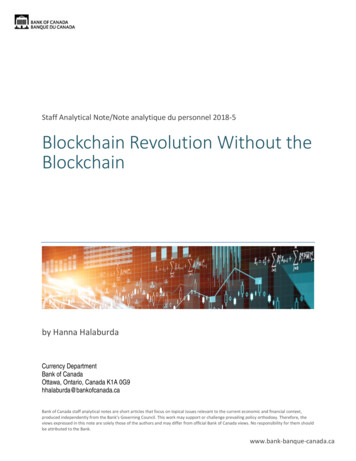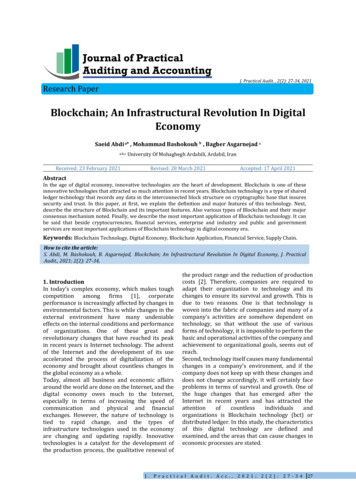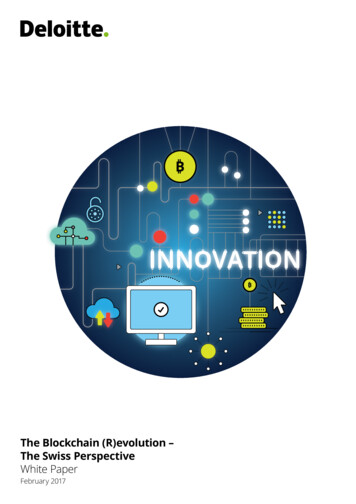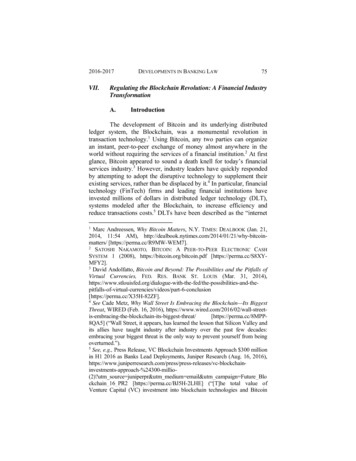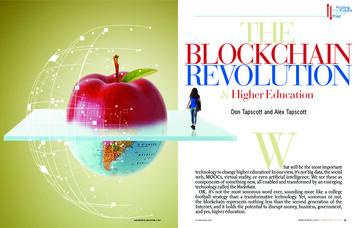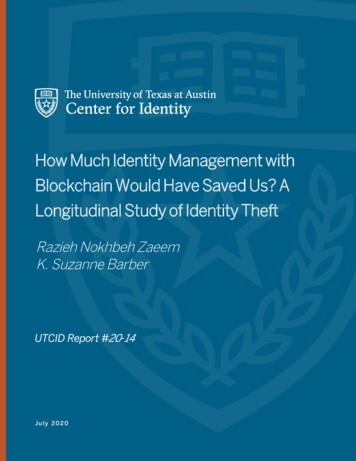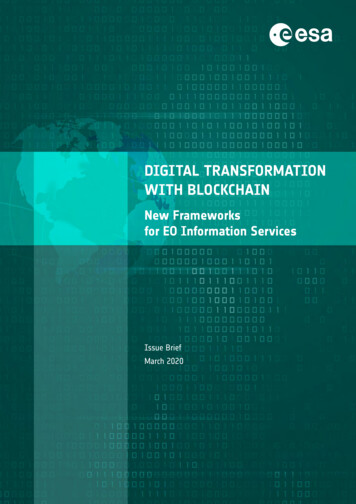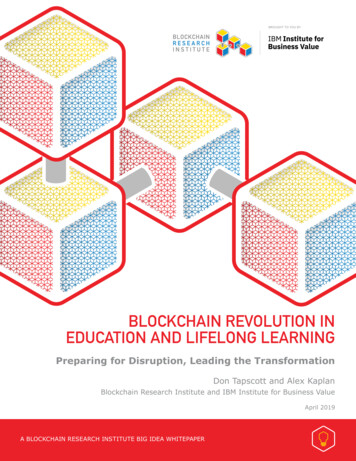
Transcription
BROUGHT TO YOU BYBLOCKCHAIN REVOLUTION INEDUCATION AND LIFELONG LEARNINGPreparing for Disruption, Leading the TransformationDon Tapscott and Alex KaplanBlockchain Research Institute and IBM Institute for Business ValueApril 2019A BLOCKCHAIN RESEARCH INSTITUTE BIG IDEA WHITEPAPER
Realizing the new promise of the digital economyIn 1994, Don Tapscott coined the phrase, “the digital economy,” with hisbook of that title. It discussed how the Web and the Internet of informationwould bring important changes in business and society. Today the Internetof value creates profound new possibilities.In 2017, Don and Alex Tapscott launched the Blockchain Research Instituteto help realize the new promise of the digital economy. We research thestrategic implications of blockchain technology and produce practicalinsights to contribute global blockchain knowledge and help our membersnavigate this revolution.Our findings, conclusions, and recommendations are initially proprietary toour members and ultimately released to the public in support of our mission.To find out more, please visit www.blockchainresearchinstitute.org.Blockchain Research Institute, 2019Except where otherwise noted, this work is copyrighted 2019 by theBlockchain Research Institute and licensed under the Creative CommonsAttribution-NonCommercial-NoDerivatives 4.0 International Public License.To view a copy of this license, send a letter to Creative Commons, POBox 1866, Mountain View, CA 94042, USA, or visit e.This document represents the views of its author(s), not necessarily thoseof Blockchain Research Institute or the Tapscott Group. This material is forinformational purposes only; it is neither investment advice nor managerialconsulting. Use of this material does not create or constitute any kind ofbusiness relationship with the Blockchain Research Institute or the TapscottGroup, and neither the Blockchain Research Institute nor the Tapscott Groupis liable for the actions of persons or organizations relying on this material.Users of this material may copy and distribute it as is under the terms ofthis Creative Commons license and cite it in their work. This document maycontain material (photographs, figures, and tables) used with a third party’spermission or under a different Creative Commons license; and users shouldcite those elements separately. Otherwise, we suggest the following citation:Don Tapscott and Alex Kaplan, “Blockchain Revolution in Educationand Lifelong Learning: Preparing for Disruption, Leading theTransformation," preface by Alex Kaplan, Blockchain ResearchInstitute and IBM Institute for Business Value, 25 May 2018, rev. 23April 2019.The first version was titled, "Blockchain Revolution in Higher Education:Preparing for Disruption, Leading the Transformation," by Don Tapscottand published by the Blockchain Research Institute. To request permissionfor remixing, transforming, building upon the material, or distributing anyderivative of this material for any purpose, please contact the BlockchainResearch Institute, www.blockchainresearchinstitute.org/contact-us, and put“Permission request” in subject line. Thank you for your interest!
ContentsPreface3Idea in brief4Introduction to student self-sovereignty5What is the blockchain revolution?7Blockchain, identity, and student records9The three challenges: Privacy, validity, and time10Privacy and cybersecurity in edtech14Blockchain and the new pedagogy17Models that balance independence andinterdependence18Alternative education: Conditional training andthe token economy19Lifelong learning and new collar jobs20Education finance: Funding academic success22The blockchain and the meta-university24Stage 1: Content exchange26Stage 2: Content co-innovation26Stage 3: Global network28Blockchain standards creation30Global initiatives30Education stakeholder initiatives31Incentives to change32Conclusion and recommendations33About the authors35About the Blockchain Research Institute37About the IBM Institute for Business Value38Notes39
BLOCKCHAIN REVOLUTION IN EDUCATION AND LIFELONG LEARNINGPrefaceIBM has been integrally involved with the transformation of educationfrom its earliest days. As the computing revolution took flight in the1950s, IBM worked closely with education institutions to leveragethose new technologies and prepare people with the knowledgeneeded to be successful in the information technology revolution.IBM’s commitment to the application of advanced technologies torevolutionize education continues to this day.As one of the world’s largest employers, we see the potential ofblockchain in support of our talent management strategies inpreparing current and future employees for the new-collar jobs of thefuture. IBM’s current work in education focuses on the applicationof artificial intelligence (AI), blockchain, and other advancedtechnologies to support the mission of educators, educationinstitutions, and companies by creating solutions that enable learnersand educators to enjoy the benefits of personalized learning at scale.Blockchains can empower individuals to design their own pathwaysover a lifetime of learning and work. Blockchains also introduce trust,transparency, and efficiency into an education system that can bedifficult to navigate and use. These benefits are multiplied by thepower of blockchain to create secure and connected networks ofeducation institutions, education technology (edtech) companies, andlearners. Enabling the secure sharing and exchange of data, in a selfsovereign framework, shifts control of learning to the individual, andaway from the institution. This shift offers the potential to transformthe education ecosystem fundamentally.IBM’s work in education and blockchain focuses on solving the bigproblems and being a leader in applying blockchain to transformeducation. Working with key thought leaders on blockchain isan essential element in achieving IBM’s objectives. IBM’s ownresearch into the application of blockchain in education is stronglycomplemented by our collaboration with Don Tapscott and theBlockchain Research Institute. Our combined thinking allows bothorganizations to offer more profound insights to the emergence ofblockchain technology within education.ALEX KAPLANMemberIBM Industry Academy, Education3 2019 BLOCKCHAIN RESEARCH INSTITUTE IBM INSTITUTE FOR BUSINESS VALUE
BLOCKCHAIN REVOLUTION IN EDUCATION AND LIFELONG LEARNINGIdea in brief»» Self-sovereign identity is becoming a possibility: The conceptof a self-sovereign and inalienable digital identity is criticalto society in general and to students in particular. It meansthat our identities and the data associated with them areneither bestowed nor revocable nor owned by any centraladministrator (such as a university, an academic testingcompany, or a licensing agency) and are enforceable in anycontext—in person and online—anywhere in the world.»» Students, parents, and employees will begin claiming rights totheir learning data: Education institutions and companies mustput ownership of student data into the hands of students (andtheir parents) and employees. Blockchain enables learners toown and control their own data but not alter their grades ordegrees or certifications.1»» Protecting the privacy and cybersecurity of students isTo remain relevant,institutions must begintransforming how theymeasure, record, andcredential studentaccomplishments, and howthey secure these recordsover time.paramount: In recent years, questions of identity, security,and privacy of student data have challenged providers andusers of edtech. University systems have been hacked, andtheir reputations tarnished. Technology companies such asIBM, institutions such as MIT, standards organizations suchas IMS Global Learning Consortium, and blockchain educationcompanies such as Learning Machine are at the forefront ofpreserving these student rights.»» Microcredentialing of skills and know-how is on the rise: Toremain relevant, education institutions and companies mustbegin transforming how they measure, record, and credentialstudent accomplishments and mastery of skills, both insideand outside the classroom, and how they secure these recordsover time. Mass adoption of blockchain as the trust anchor ofone truth for credentials flips the power relationship betweenthe educator and the students. Individuals become their ownlifelong registrar and academic and career advisor and canshare their skills broadly.»» Educators who want to attract students will continue tochange their pedagogy: Newer models of collaborativeteaching and learning—where students create and sharetheir knowledge worldwide—are driving the customization ofeducational content and environments to fit the needs andabilities of each student.»» New funding models are emerging through blockchain: Inaddition to lower administrative costs and risks, distributedledger technology enables alternative ways to pay foreducation, such that more people from a diversity of locationsand backgrounds can participate without burdening familieswith student debt.4 2019 BLOCKCHAIN RESEARCH INSTITUTE IBM INSTITUTE FOR BUSINESS VALUE
BLOCKCHAIN REVOLUTION IN EDUCATION AND LIFELONG LEARNING»» The meta-university is in the making: More people around theLearners everywhereare curating their owneducation, and employersare encouraging them to doso.world are learning from TED Talks, incorporating MIT’s opencourseware in their syllabi, participating in free massive openonline courses (MOOCs), and receiving industry-recognizedcertifications for their participation and completion in theselearning activities. Employers are investing more aggressivelyin reskilling their employees for new-collar jobs and focusingmore on skills than degrees. In other words, learnerseverywhere are curating their own education, and employersare encouraging them to do so.2Introduction to student self-sovereigntyBlockchain technology provides a secure and innovative meansof realizing the concept of the self-sovereignty, referring to anindividual’s supreme authority over and complete ownership of thatindividual’s personhood. The self-sovereign identity springs from ourinalienable right to claim our selves and determine who we are in theworld. Until now, we have relied on governments to secure that rightand enforce that authority.3With distributed ledgers, we will soon be able to establish andadminister our own digital identities and easily so. A prominentsolution to empower digital identities is emerging from the SovrinAlliance, in collaboration with such companies as Cisco, IBM,T-Mobile, and others:The Sovrin Network is a new standard for digital identity—designed to bring the trust, personal control, and ease ofuse of analog IDs—like driver’s licenses and ID cards—tothe Internet. [The Sovrin Alliance wants] to give people,organizations, and things the freedom to collect and carrytheir own lifelong verifiable digital credentials.4Blockchain technologyprovides a secure andinnovative means ofrealizing the concept of theself-sovereignty.5In this context, self-sovereign means that “individual identityholder[s] can access, use, and share their credentials on the SovrinNetwork whenever and however they please.”5 Through suchsolutions, the parents of a newborn or possibly the doulas, midwives,or obstetricians who assisted in the birth of a child, can initiate adigital identity for the child on the blockchain, an identity owned bythe child and administered by the parents or guardians until the childis ready to assume administrative rights.Until that point of transfer, parents can pick and choose how muchof their child’s identity to reveal—such as inherent data (age, DNA,birth date, birth place), assigned data (name), and selected data(gender)—and whether others can view or contribute to data relatedto the health, religious instruction, or academic achievement of thechild. They may choose to anonymize their child’s data for usagein research, in exchange for a fee that would accrue to pay for thatchild’s healthcare or education. 2019 BLOCKCHAIN RESEARCH INSTITUTE IBM INSTITUTE FOR BUSINESS VALUE
BLOCKCHAIN REVOLUTION IN EDUCATION AND LIFELONG LEARNINGWe see the possibility ofmaking better matchesbetween students andteachers through onlineeducation platforms, andbetween job seekers andemployers through trustedskills marketplaces.From pre-kindergarten onward, both traditional and nontraditionalinstitutions of learning will associate each student’s grades, testscores, and skill mastery to that student’s digital identity andtransfer rights to those data to the student, parents, or employeras appropriate. As it develops, the digital identity will encompassall aspects of an individual’s knowledge and learning such as extracurricular activities and awards as well as abilities to collaborate ingroups or to lead teams. Those who want to pursue education andcareer advancement will have not just a multidimensional portfolio ofdata about what they know and have to offer but also an account forfunding their pursuits.As digital identities using blockchain become more robust and widelyadopted, and education—like the workplace—becomes increasinglydigital and virtual, we see the possibility of making better matchesbetween students and teachers through online education platforms,and between job seekers and employers through trusted skillsmarketplaces. Giving students greater freedom to focus on contentcreation, learning will become a social experience, one in which topractice teamwork and collaboration.6 Internships, part-time jobs,and skill building assignments will become indistinguishable, asstudents will be able to apply each newly learned skill immediately inthe job market.Blockchain also has the capacity to change relationships amongcolleges, universities, employers, and their relationships to society.As we delve deeper into blockchain and education, we look into howdistributed ledger technology supports institutional and corporatelearning and secures the academic records of refugees, immigrants,and students in emerging economies.With portable identitiescomes the need forinteroperable standardsand data governancepolicies in the blockchainspace.With portable identities comes the need for interoperable standardsand data governance policies in the blockchain space. Educators,parents, and employers should lead the conversations aboutstandards setting and governance. The current mishmash ofidentifications—with each jurisdiction, each institution, each skillcertification, and each test administrator issuing its own type ofstudent ID and skill or course schema—thwarts the individual’sunderstanding, collection, use, and analysis of all the data associatedwith that individual’s identity.Blockchains and their successors as well as the identities preservedon them will go through a period of divergence and convergence.As more blockchains are built for different spheres of our lives—asmedical patients, voting citizens, bank balance holders, lifelonglearners, home owners, social security beneficiaries, and consumersof food, insurance, and transportation—the more identifiers (that is,the more account numbers) we will be asked to manage in order toparticipate. Simultaneously, the breaking down of these siloes onthe blockchain will ensure an aggregation of these disparate flows ofdata.While all these data and metadata become more portable andinteroperable, blockchain’s value of trust will increase in importance.6 2019 BLOCKCHAIN RESEARCH INSTITUTE IBM INSTITUTE FOR BUSINESS VALUE
BLOCKCHAIN REVOLUTION IN EDUCATION AND LIFELONG LEARNINGIt strengthens the aggregation and preservation of a person’s dataover time and the verifiability of identity system-wide, and allows forsecure sharing of that data, all to the benefit of that person.With the current Internetof information, we rely onpowerful intermediariessuch as governments,banks, and digital platformsto protect and transmitthings of value.What is the blockchain revolution?Today’s Internet is great for communicating and collaborating inthe classroom, but it was built for moving and storing informationrather than protecting student and teacher rights and preservingvalue of quality content. It has done little to change how we manageacademic institutions, recognize and codify skills and talent,help people manage their own pathways, fund education, or helpemployers manage the talent pipeline.When professors exchange student information (e.g., e-mail, lecturenotes, presentations, or an audio recording of a lecture), they arenot sending the original, but merely a copy. Although it is acceptable(and indeed advantageous) for students to share lecture notes andpresentation files, it shocks the ordinary senses for students toplagiarize their classmate’s homework or take tests online for theirclassmates. When companies issue digital badges to their employees,and those employees post them to LinkedIn, it makes us wince to seeother people copy those badge images to their own LinkedIn profileand present them as authentic. Thus, with the current Internet ofinformation, we continue to rely on powerful intermediaries suchas governments, banks, and digital platforms (e.g., Amazon, eBay,Airbnb, and colleges and universities) to protect and transmit thingsof value. These third parties do the work of establishing our identityand vouching for our trustworthiness, and they acquire and transferassets as well as settle transactions.Even though these intermediaries may seem to work to oursatisfaction, they have vulnerabilities and shortcomings that can hurtour data and us. They use hackable, centralized servers. They takea piece of the value pie for performing a service, such as 10 percentto send money internationally. They capture our data, not justpreventing us from using it for our own benefit but often underminingour privacy. The intermediaries can be unreliable and slow.Using the highest level ofcryptography, digital assetsare distributed across aglobal ledger.Most problematically, they exclude two billion people who don’t haveenough money to justify a bank account, let alone an education.Those two billion people can’t capture the benefits of the digital age.With blockchain technology, digital assets—everything from money,stocks, bonds, and intellectual property to music, art, loyalty points,student records, and credentials—are not stored in a central place.They are distributed across a global ledger, using the highest levelof cryptography. Transactions are posted globally across millions ofcomputers.7 2019 BLOCKCHAIN RESEARCH INSTITUTE IBM INSTITUTE FOR BUSINESS VALUE
BLOCKCHAIN REVOLUTION IN EDUCATION AND LIFELONG LEARNINGThe Bitcoin blockchainis the most highprofile example of thetechnology’s potential.Another massivelyadopted blockchain isEthereum, which enablesprogrammers to createsmart contracts.Around the world is a group of people called miners who havemassive computing power at their fingertips—10 to 100 times biggerthan all of Google worldwide. Every 10 minutes, much like theheartbeat of a network, these miners assemble all transactions fromthe previous 10 minutes into a block. Then they compete to solve atough mathematical problem; whoever solves the problem gets tovalidate the block and receives some digital currency as a reward.In the case of the Bitcoin blockchain, the winner gets bitcoin. Next,that block is linked to the previous block and to the block before that,to create a chain of blocks. Every block is time-stamped, as with adigital waxed seal.So if someone wanted to hack a block and, say, send the samebitcoin to several people, he’d have to hack that block plus all thepreceding blocks, through the entire history of that bitcoin onthe blockchain—not just on one computer but across millions ofcomputers, simultaneously, all using the highest levels of encryption.Tough to do—and infinitely more secure than the computer systemsthat we use today.The Bitcoin blockchain is the most high-profile example of thetechnology’s potential. Another massively adopted blockchain isEthereum, which was developed by 22-year-old Canadian VitalikButerin. Ethereum has some extraordinary capabilities and tools. Forexample, it enables programmers to build smart contracts, which areagreements translated into lines of computer code that handle theenforcement, management, performance, and payments of contractsbetween people. There are projects on the Ethereum blockchainto create a replacement for the stock market and a new model ofdemocracy, where politicians are accountable to citizens.New blockchains are emerging all the time that enable different andpowerful changes to the status quo. For example, in December 2015,the Linux Foundation launched Hyperledger with support from bigindustry players like IBM, Intel, and SAP Ariba:7For education, issuers ofcredentials need to controlthose credentials over thecredential’s lifespan.8The Hyperledger Project is a collaborative effort to focus onan open platform that will satisfy a variety of use cases acrossmultiple industries to streamline business processes. Peerto peer in nature, distributed ledger technology is shared,transparent, and decentralized. By creating a cross-industryopen standard for distributed ledgers, virtually any digitalexchange with value, such as [credentials] can securely andcost-effectively be tracked and traded.8In addition, industries can explore the use of permissioned or closedledger blockchains to strengthen the governance structures ofblockchain networks. For education, issuers of credentials need tocontrol those credentials over the credential’s lifespan. A credentialissued for a veterinarian or accountant requires periodic renewal, andthe issuer requires the ability to manage that credential, ensuring itis always correct and valid. In addition, all credential-issuing bodieshave an interest in assuring that all issuers to the blockchain arelegitimate credentialing entities and that no one can write fraudulent 2019 BLOCKCHAIN RESEARCH INSTITUTE IBM INSTITUTE FOR BUSINESS VALUE
BLOCKCHAIN REVOLUTION IN EDUCATION AND LIFELONG LEARNINGcredentials to the blockchain. Permissioned blockchains provide thetechnical ability to address these requirements and when combinedwith strong governance structures are ideal for education.Studying alone by varunkul01 (Varun Kulkarni), 2016, used under Pixabay license,accessed 15 April 2019.Blockchain, identity, and student recordsToday’s society—or at least today’s employers, includinggovernments—values academic credentials as exemplars of masteryof skills. As long as students are willing to pay more for recognizedand highly ranked brand names on their diplomas rather than pursuealternatives, then the well-known college or university will remain agatekeeper to opportunity.Today’s society valuesacademic credentials. Assuch, well-known collegesand universities remaingatekeepers to opportunity.The credentials and even the prestige of education institutions arerooted in the perceived effectiveness of the learning institution.Increasingly, employees are evaluating companies on their ability toprovide high quality learning experiences. If colleges, universities,and employers come to be seen as places where learning is inferiorto other models or, worse, as places where learning is restrictedand stifled, then the role of the campus experience, the desirabilityof the job, and the value of the credential itself will be undermined.Attending the wrong college or picking the wrong employer is toocostly.So what counts as a credential? What counts as a qualitypostsecondary credential? Who defines quality and how? What countsas an education institution? All of these questions become morerelevant in the education space as blockchain takes over.9 2019 BLOCKCHAIN RESEARCH INSTITUTE IBM INSTITUTE FOR BUSINESS VALUE
BLOCKCHAIN REVOLUTION IN EDUCATION AND LIFELONG LEARNINGBlockchain can beprogrammed to recordvirtually everything ofvalue and importance to aperson’s life.“Today you need an organization with endowed rights to provide youwith an identity,” said Carlos Moreira of WISeKey.9 This process ofidentity usually begins with a birth certificate issued by the state,with information from a licensed medical professional. From thatday forward, human beings generate personal data through everystage of life. All of this will be in analog form, usually handwritten.Blockchain can be programmed to record virtually everything ofvalue and importance to a person’s life. This is a huge opportunity,and it presents three primary challenges.The three challenges: Privacy, validity, and timePrivacyThe first challenge is to maintain the privacy and security ofindividuals’ data. In 2013, the Education Advisory Board (EAB) inWashington DC published a list of 157 strategies for collecting dataabout students and alumni for colleges and universities to exploit infundraising efforts, and institutions have become good at doing so.10When it comes to protecting students’ data, however, colleges anduniversities are as vulnerable as any other large organization. Forexample:»» The University of California–Berkeley, Ohio State University,the University of Wisconsin–Milwaukee, and KirkwoodCommunity College have been hacked in recent years.»» Yale University accidentally published confidential informationonline.»» Indiana University hosted private data on an unprotected site.»» The University of Utah Hospitals and Clinics, StanfordUniversity, and the University of Miami stored data on laptopsor data tapes that were later stolen.11Hyperledger Fabric, a fastemerging blockchain, lendsitself well to education,allowing two partiesanywhere in the world toshare official academicrecords securely.The blockchain protects data by using public key infrastructure(PKI) for establishing a secure platform. PKI is an advanced form ofasymmetric cryptography. Users get two keys that don’t perform thesame function: one is for encryption and the other for decryption—hence, they are asymmetric.The Bitcoin blockchain is now the largest civilian deployment of PKI inthe world, second overall to the US Department of Defense’s commonaccess system.12 Hyperledger Fabric, a fast emerging blockchain,lends itself well to education. Sony Global Education has adaptedthis technology to secure educational record integrity, allowing twoparties anywhere in the world to share official academic recordssecurely.13 Without the exact two keys, a hacker cannot access thedata.ValidityThe second challenge to address is validity. At a time wheninformation is abundant, fleeting, and mutable, employers place10 2019 BLOCKCHAIN RESEARCH INSTITUTE IBM INSTITUTE FOR BUSINESS VALUE
BLOCKCHAIN REVOLUTION IN EDUCATION AND LIFELONG LEARNINGmore importance on verifying job prospects’ claims. CareerBuilderreported in 2014 that 57 percent of job applicants had been caughtembellishing their skills set, 33 percent had lied about their academicdegree, and 31.1 percent of employers had either rescinded a joboffer or fired an employee for falsely representing their credentials.14Unsurprisingly, therefore, employers want to see official educationtranscripts.At a time when informationis abundant, fleeting, andmutable, employers placea lot of importance onverifying job prospects’claims.However, universities often charge transaction fees to providetranscripts, and transcript issuance is growing. Sixty-two percenthave seen an increase in the number of official transcripts issued bytheir institution in the last five years at an average cost to studentsbetween 5.00 and 9.99.15 A blockchain credential solution couldmake the transfer of such information quickly, comparatively costfree, and completely trusted. If such a system were adopted widely,imagine how it could benefit, say, refugees who are seeking tocontinue their education or find a job in a new country. Or imaginea process where a university could pro-actively offer admission to ahigh school student in an underserved community based upon thatstudent’s trusted portfolio of education and credentials.TimeThe third challenge to address is time. In the United States, only 25percent of students attend college full-time at residential campuses.The rest are juggling work and family. These part-time students taketwice as long to graduate, and only one-quarter of them actually earna degree.16Open Badges, Blockchain Certificates, and Learning is Earning2026 are some of the initiatives exploring ways to credentialstudents for everything they learn, no matter the setting.17 Eventhe US Department of Education has been moving forward with itsEducational Quality through Innovation Partnerships (EQUIP) pilotprogram, announced in 2015. The pilot is to allow, for the first time,federal aid to low-income students who enroll in non-traditionaltraining such as coding boot camps. Its goal is “to provide faster, lessexpensive pathways to credentials of value.”18Education funding for blockchain credentialing start-ups has alsoincreased. These start-ups offer an alternative credential platform orproduct, and raised venture capital in 2016:»» Degreed ( 24.5 million)—investors include Jump Capital,Signal Peak, Rethink Education, Deborah Quazzo, and GSVAcceleration19»» Credly ( 2.5 million)—investors include University Ventures,New Markets Venture Partners, Lumina Foundation VentureFund, City & Guilds Group, and Lion Brothers CompanyRelated investments in MOOCs and coding boot camps, both of whichoffer certificates, will also serve as alternative forms of credentials.Acquisitions for credentialing start-ups in 2016 included Digitalme11 2019 BLOCKCHAIN RESEARCH INSTITUTE IBM INSTITUTE FOR BUSINESS VALUE
BLOCKCHAIN REVOLUTION IN EDUCATION AND LIFELONG LEARNINGand Makewaves, acquired by City & Guilds, and LinkedIn acquiredby Microsoft.20 Also, firms that focus on credentialing are lookingto aggregate both volume and scale,
Don Tapscott and Alex Kaplan, "Blockchain Revolution in Education and Lifelong Learning: Preparing for Disruption, Leading the Transformation," preface by Alex Kaplan, Blockchain Research Institute and IBM Institute for Business Value, 25 May 2018, rev. 23 April 2019. The first version was titled, "Blockchain Revolution in Higher Education:
